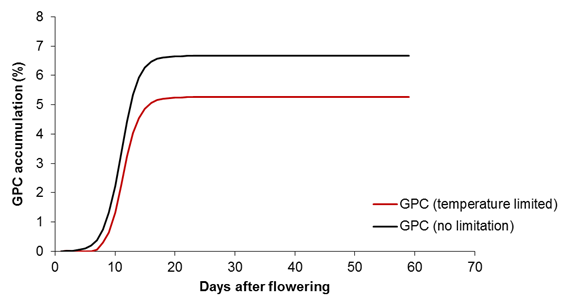The model provides a dynamic simulation of the protein content in the rice grain considering the peculiar effect of temperature and irrigation management on its daily accumulation in post flowering. The model also considers both the intensity and the duration of the varietal sensitivity to suboptimal thermal regimes for the synthesis of protein compounds.
The grain protein content accumulated at day "i" is simulated using the following equation (Figure1):

Where:
GPCi (%, D.W.) is the protein content of rice kernel simulated in the i-th day after flowering (D.W.);
GPavg (%, D.W.) is the reference grain protein content, typical of the simulated rice variety;
DFFi (d) are the days from flowering date;
LTi (%) represents the percentage of protein daily losses due to suboptimal temperatures during the ripening phase;
IF (unitless) is a parameter accounting for the effect of irrigation management on cracking occurrence;
NTavg (°C) is the average nighttime temperature perceived by the rice crop during the R8 phase of ripening (between DVS 2.5 and 3);
NTT (24.09 for Loto variety, 25.2 for Gladio variety; °C) is the nighttime temperature threshold above which the irrigation management adopted by rice growers affect the grain protein content of the grain;
aj (-0.6924 for Loto variety, -0.5 for Gladio variety; unitless),bj (7.6016 for Loto variety, 12 for Gladio variety; unitless) and cj (1.0104 for Loto variety, 1.0499 for Gladio variety; unitless) are coefficients of the equation.

Figure 1. Grain protein accumulation (GPC, %) along the ripening period. The black line represents the potential grain protein concentration that can be achieved under optimum temperature conditions, whereas the red one indicates the actual grain protein concentration due the effect of suboptimal thermal regimes.
The Irrigation factor, varies depending on the irrigation management used to grow the rice crop. In Northern-Italian conditions, the default values are:
The daily thermal limitation to protein accumulation due to suboptimal temperatures is calculated as follow:

Where:
TFi (unitless) is the temperature factor (1 no limitation, 0 maximum limitation) accounting for the temperature effect on protein synthesis;
SDSTT (d) is a parameter representing the duration of suboptimal temperatures impact on protein synthesis.
The factor accounting for the temperature effect on protein synthesis is calculated using the following equation:

Where:
VSST (unitless) is a parameter representing the varietal sensitivity (0 maximum sensitivity, 1 no sensitivity) to suboptimal thermal regimes during the protein synthesis;
Ti (°C) is the average daily temperature of the day i;
Tmin (°C) is a parameter representing the minimum temperature threshold for the grain protein synthesis;
Tmax (°C) is a parameter representing the maximum temperature threshold for the grain protein synthesis;
ToptL (°C) is a parameter representing the lower optimum temperature threshold for the grain protein synthesis;
ToptM (°C) is a parameter representing the higher optimum temperature threshold for the grain protein synthesis;
α, β, γ , δ (unitless) are coefficients of the equation.
α is calculated as:

β is calculated as:

γ is calculated as:

δ is calculated as:

Created with the Personal Edition of HelpNDoc: Produce Kindle eBooks easily